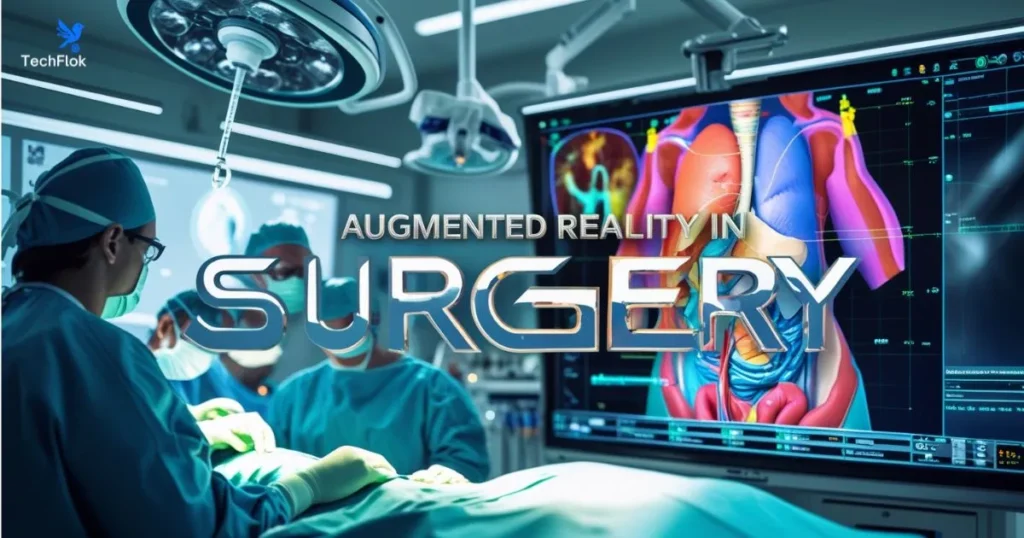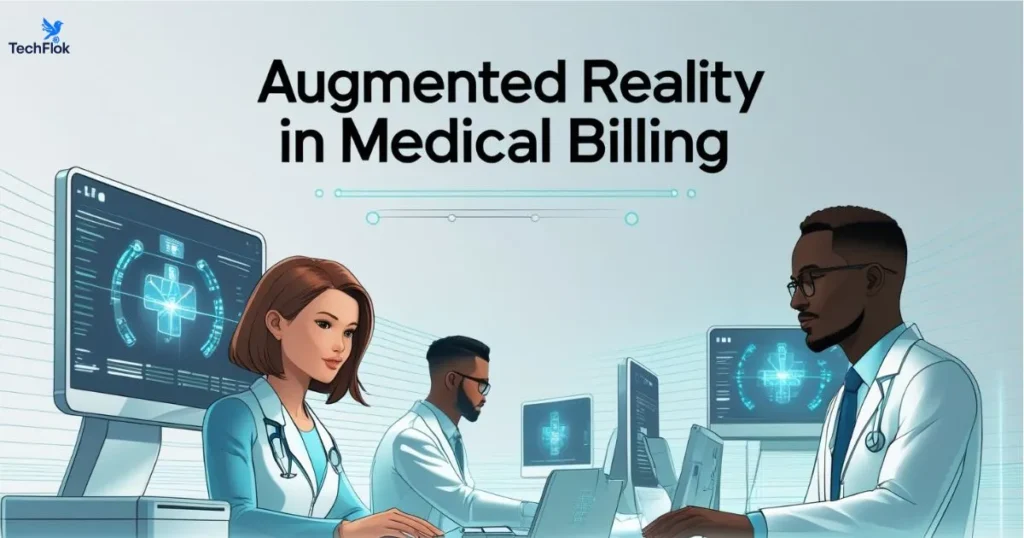
Augmented Reality in Medical is changing how healthcare works across the United States and the rest of the world. It adds digital visuals and information to the real world. Doctors can see patient data and scans instantly while they work. It isn’t science fiction. AR is already improving surgery, diagnostics, education, and billing. Medical schools now use virtual medical simulation to train future doctors.
Surgeons rely on real-time surgical guidance powered by smart glasses. Even patient consultations have evolved through interactive patient education and AR-enhanced visualizations. With the help of medical augmented reality platforms, hospitals are becoming faster, safer, and more efficient, paving the way for a brighter, patient-centered future in healthcare.
Let’s explore how this tech is helping healthcare professionals and patients across America and the rest of the World
What Is Augmented Reality in Medical Practice?
Augmented Reality in Medical practice involves projecting digital information into the real world. Doctors wear AR headsets or screens to see the patient and the digital data. These overlays include X-rays, MRI scans, or 3D models. It helps doctors make decisions more quickly and accurately. AR is often used with AI-enhanced AR navigation and real-time anatomical mapping.
This technology is beneficial in surgery, patient education, and emergency care. It also supports spatial visualization in medicine. AR can display veins under the skin or guide a surgeon’s hand during a procedure. It improves care and reduces mistakes.
Augmented Reality in Medicine
Across U.S. hospitals, AR is creating more intelligent workflows and better patient outcomes. It allows doctors to practice surgeries using a digital twin for surgery planning before they enter the operating room. With medical augmented reality platforms, they can even operate with support from remote experts.
It also helps nurses, therapists, and billing professionals do their jobs more accurately. AR supports interactive patient education, making it easier for patients to understand their treatment. As a result, people feel more engaged and trust their doctors more.
Augmented Reality in Medical Education: A New Way to Learn
In American medical schools, AR has started to replace traditional learning methods. Students no longer rely only on textbooks or physical cadavers. Instead, they use 3D holographic anatomy tools like HoloHuman and Curiscope. These platforms allow future doctors to interact with complete body systems in high detail.
It makes learning more fun and effective. In a virtual medical simulation, students can explore the heart, brain, or muscles. They gain experience without risk. It prepares them for real clinical settings, making complex topics easier to understand. In this way, Augmented Reality in Education and especially in the Medical field is a new way of learning for students
AR in Medical Training
Thanks to AR, surgery or emergency medicine training is faster and safer. Trainees use immersive medical training systems to simulate real-world tasks. They practice in safe environments before touching actual patients. AI or human instructors often guide these sessions.
AR tools like HoloLens provide real-time surgical guidance during training. The headset recognizes voice commands using a speech-recognition AR interface. Learners can control the simulation hands-free, improving hygiene and focus during mock procedures.
Role of Augmented Reality in Surgery

AR helps surgeons see what lies beneath the skin without making significant cuts in surgery. It is called non-invasive surgical guidance. AR shows in real-time organs, bones, or tumors using scans like CT or MRI. Surgeons don’t have to look away from the patient to check monitors.
Augmented reality-assisted surgery (ARAS) uses technology to add digital images to what the surgeon sees during an operation, helping them work more precisely. It allows surgeons to focus on patient-specific imaging during complex spinal surgeries. This method leads to fewer complications and quicker recovery.
Augmented Reality in Medical Imaging
AR in imaging means combining real patient scans with live views. It gives doctors a complete understanding of the body’s condition. For example, using multimodal medical visualization, AR can show blood flow paths and valve positions in heart surgery.
Radiologists and technicians benefit too. They can use gesture-based AR control to manipulate 3D images without touching a screen. It keeps environments sterile and lets them explore different angles quickly.
Augmented Reality Anatomy
For students and professionals alike, augmented reality anatomy is a game-changer. AR brings human anatomy to life in full color and detail. With tools like AR headsets, learners can view organs, nerves, and bones in 3D. Offers spatial visualization in medicine like never before.
Doctors also use these systems to explain procedures to patients. Instead of showing charts, they can walk patients through their condition using an interactive patient education system. It builds trust and helps patients make informed choices.
Augmented Reality in Medical Billing and Administration

Billing in healthcare is complex and time-consuming. AR tools now simplify these tasks. Workers can scan documents, codes, and patient files in real-time. AR overlays guide them step-by-step through billing rules and claims entry.
Some AR billing platforms include computer-generated overlays for compliance alerts. These tools flag mistakes and reduce rejected claims. They also help train new staff in billing systems more quickly.
Impact of Augmented Reality in Medical Billing
Hospitals using Augmented Reality in billing report fewer errors and faster processing times. In a recent case study, a New York clinic cut claim rejections by 37% after switching to AR billing tools. These platforms highlight missing information and visually guide coders through the process.
Because billing is a critical part of U.S. healthcare, reducing time and errors saves a lot of money. It also helps patients get their bills faster, with fewer surprises.
Augmented Reality in Healthcare
AR is used in many areas outside surgery, too. In physical therapy, AR helps patients follow rehab exercises by projecting motion targets on the floor. Therapists use wearable AR medical devices to track movements and give instant feedback.
It’s also used in mental health. AR can help patients with PTSD through exposure therapy in a safe space. These systems offer immersive environments for emotional healing.
How AR Is Improving Patient Care and Communication
Sometimes, patients struggle to understand what’s happening to them. AR bridges that gap. Doctors can use AR to show where a tumor is or how a joint replacement will work. It makes things clear for the patient.
Augmented reality healthcare apps also offer post-surgery care instructions using video and a digital twin for surgery planning. Families can watch and learn together, making support easier at home.
Augmented Reality in Pharmaceutical Applications
In pharma, AR is helping patients learn how to use medicine correctly. Some drug packages now include QR codes that activate augmented reality healthcare apps. These apps show how to use an inhaler or an insulin pen safely.
Drug companies use AR to train staff and market new products. A company in Australia built a prototype for Bayer that explains drug ingredients and effects using AR. It improves safety and trust.
Telemedicine and Remote Care with AR Integration
During the COVID-19 pandemic, many U.S. hospitals used AR to limit exposure. One doctor wearing AR glasses could walk into a room while the team watched from another location. They could share notes and images through a computer-generated overlay.
In rural areas, AR is now used for ultrasound and emergency care. A nurse can scan a patient while a remote expert guides the process using AI-enhanced AR navigation. It’s saving lives where specialists are scarce.
Augmented Reality for Preoperative Planning and Simulation
Before any complex surgery, planning is key. AR gives surgeons the ability to rehearse with real patient data. They can rotate organs, zoom into problem areas, and decide the best route for operation.
It is done using a digital twin for surgery planning. The better the plan, the fewer surprises in the operating room. It also improves communication between surgical teams.
Benefits and Challenges of AR in Healthcare Systems
The benefits of AR are clear: better precision, faster decisions, and more confident patients. U.S. hospitals using AR report speedier recovery times and fewer surgical errors. Smart glasses in surgery keep doctors focused without looking away from the patient.
Still, challenges remain. AR systems are expensive. They need constant updates, training, and privacy controls. Patient data must be kept secure, and regulations must be adhered to. But the results are worth the effort.
Real World Applications of Augmented Reality in Medicine
At Cedars-Sinai in Los Angeles, AR is successfully used in spinal procedures. In New York, virtual anatomy classes are taught through AR headsets. Even the military uses AR to train medics in battlefield conditions.
In another case, AR helped a surgeon in Boston remove a tumor near the optic nerve with zero complications. These real stories prove AR is not just a theory it’s saving lives today.
Ethical and Regulatory Considerations of AR in Health
When using AR, hospitals must consider ethics and regulations. Who owns the AR data? How is it stored? Is it safe from hackers? These are essential questions.
Doctors must also avoid relying too much on machines. AR should assist, not replace, human skills. Regulators are working on new standards to guide safe use.
Future of Augmented Reality in Medical Technology
The future looks bright. Experts believe AR will be paired with AI to create systems that think and adapt in real-time. Patients may soon wear AR devices at home to monitor chronic diseases.
AR will become standard in U.S. hospitals and clinics as costs drop and tech improves. It promises faster care, fewer risks, and better outcomes for all.
Conclusion
Augmented Reality in Medical is moving fast. It’s helping doctors see better, treat faster, and teach smarter. From real-time surgical guidance to interactive patient education, AR is making healthcare stronger.
More hospitals use tools like smart glasses in surgery and virtual medical simulation. It saves time, improves care, and helps patients heal. The future of medicine isn’t far, it’s already happening with AR.
Frequently Asked Questions
What are the negatives of using AI in healthcare?
AI in healthcare may misinterpret data, rely on biased training sets, and lack human empathy, leading to incorrect or impersonal decisions.
What are the downsides of AR?
AR can be costly, needs regular updates, and may cause distractions or technical issues during medical procedures if not used carefully.
What are the three disadvantages of using robots in caring roles?
Robots can lack emotional understanding, reduce human interaction, and struggle in unpredictable caregiving situations.
What are the pros and cons of using robots in healthcare?
They offer precision, consistency, and support for staff, but are expensive, need maintenance, and may replace human jobs or empathy-based care.
What is the problem with augmented reality?
AR devices are costly, require high skill and training, and may raise privacy or safety concerns in sensitive healthcare environments.
What are some examples of augmented reality?
Examples include AR for vein detection, 3D holographic anatomy tools in education, and smart glasses in surgery for real-time surgical guidance.
How is augmented reality used in healthcare?
It’s used for non-invasive surgical guidance, virtual medical simulation, patient education, therapy, billing, and improving clinical decision-making.
What are the five types of augmented reality?
These include marker-based AR, markerless AR, projection-based AR, superimposition-based AR, and SLAM (Simultaneous Localization and Mapping).
Do surgeons use augmented reality?
Yes, surgeons use AR for real-time anatomical mapping, pre-surgery planning, and to guide precise movements during operations.
What are the disadvantages of augmented reality in healthcare?
Disadvantages include high setup costs, technical complexity, limited user training, and potential for gesture-based AR control errors in surgery.


